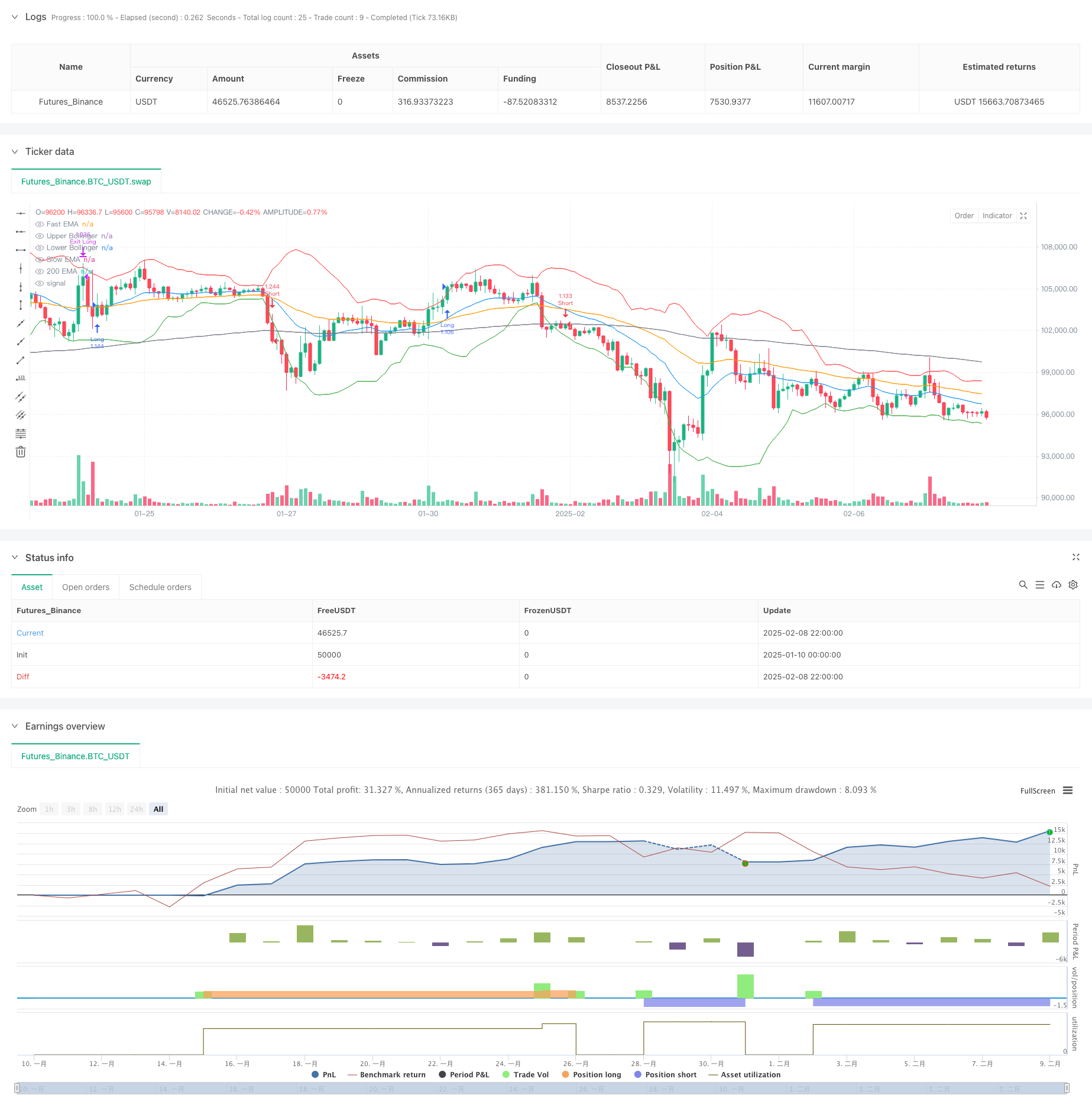
概述
本策略是一个结合了多重技术指标的趋势跟踪系统,通过整合移动平均线(EMA)、相对强弱指标(RSI)、移动平均线趋同散度指标(MACD)和布林带(BB)等指标,构建了一个完整的交易决策框架。该策略采用动态的风险管理方法,包括基于百分比的止损和基于风险收益比的止盈设置,旨在实现稳健的风险调整后收益。
策略原理
策略的核心逻辑基于多层面的市场分析: 1. 趋势确认:使用200日EMA确定长期趋势方向,快速EMA(20日)和慢速EMA(50日)的交叉确认中期趋势变化 2. 动量验证:利用RSI指标和MACD双重验证市场动量,要求RSI位于50以上(多头)或50以下(空头),同时MACD信号线支持相应方向 3. 波动性控制:通过布林带进行交易时机的精确把握,在下轨支撑位寻找做多机会,在上轨阻力位寻找做空机会 4. 风险管理:采用2%的止损设置和1.5倍风险收益比的止盈水平,确保每笔交易的风险可控
策略优势
- 多维度分析:通过结合趋势、动量和波动性指标,降低假信号的影响
- 风险控制完善:预设的止损和止盈水平确保了交易的风险可控性
- 适应性强:策略参数可根据不同市场环境进行调整
- 执行明确:入场和出场条件清晰,易于实施和监控
- 资金管理合理:采用账户权益百分比进行仓位控制,避免过度风险
策略风险
- 市场波动风险:在高波动期间可能触发频繁的止损
- 趋势反转风险:在趋势转折点可能出现较大回撤
- 参数优化风险:过度优化可能导致过拟合
- 执行滑点风险:在流动性不足时可能面临较大滑点
- 佣金成本风险:频繁交易可能产生较高交易成本
策略优化方向
- 动态参数调整:可根据市场波动率自动调整指标参数
- 增加市场情绪指标:引入成交量等指标增强信号可靠性
- 优化止损机制:实现跟踪止损,提高盈利保护能力
- 引入时间过滤:增加交易时间窗口的筛选
- 加入波动率过滤:在过度波动时期降低仓位或暂停交易
总结
该策略通过综合运用多个技术指标,建立了一个完整的趋势跟踪交易系统。通过严格的风险管理和多维度的市场分析,策略具有较好的适应性和稳定性。虽然存在一定的优化空间,但整体框架设计合理,适合作为中长期交易策略的基础。策略的成功实施需要持续的监控和及时的参数调整,以适应不同的市场环境。
策略源码
/*backtest
start: 2025-01-10 00:00:00
end: 2025-02-09 00:00:00
period: 2h
basePeriod: 2h
exchanges: [{"eid":"Futures_Binance","currency":"BTC_USDT"}]
*/
//@version=5
strategy("Altcoin Long/Short Strategy", overlay=true, initial_capital=1000, default_qty_type=strategy.percent_of_equity, default_qty_value=200, commission_type=strategy.commission.percent, commission_value=0.1)
// —————— Inputs ——————
emaFastLength = input.int(20, "Fast EMA")
emaSlowLength = input.int(50, "Slow EMA")
rsiLength = input.int(14, "RSI Length")
bbLength = input.int(20, "Bollinger Bands Length")
riskRewardRatio = input.float(1.5, "Risk/Reward Ratio")
stopLossPerc = input.float(2, "Stop Loss %") / 100
// —————— Indicators ——————
// Trend: EMAs
emaFast = ta.ema(close, emaFastLength)
emaSlow = ta.ema(close, emaSlowLength)
ema200 = ta.ema(close, 200)
// Momentum: RSI & MACD
rsi = ta.rsi(close, rsiLength)
[macdLine, signalLine, _] = ta.macd(close, 12, 26, 9)
// Volatility: Bollinger Bands
basis = ta.sma(close, bbLength)
dev = ta.stdev(close, bbLength)
upperBand = basis + 2 * dev
lowerBand = basis - 2 * dev
// —————— Strategy Logic ——————
// Long Conditions
longCondition =
close > ema200 and // Long-term bullish
ta.crossover(emaFast, emaSlow) and // EMA crossover
rsi > 50 and // Momentum rising
close > lowerBand and // Bounce from lower Bollinger Band
macdLine > signalLine // MACD bullish
// Short Conditions
shortCondition =
close < ema200 and // Long-term bearish
ta.crossunder(emaFast, emaSlow) and // EMA crossunder
rsi < 50 and // Momentum weakening
close < upperBand and // Rejection from upper Bollinger Band
macdLine < signalLine // MACD bearish
// —————— Risk Management ——————
stopLoss = strategy.position_avg_price * (1 - stopLossPerc)
takeProfit = strategy.position_avg_price * (1 + (riskRewardRatio * stopLossPerc))
// —————— Execute Trades ——————
if (longCondition)
strategy.entry("Long", strategy.long)
strategy.exit("Exit Long", "Long", stop=stopLoss, limit=takeProfit)
if (shortCondition)
strategy.entry("Short", strategy.short)
strategy.exit("Exit Short", "Short", stop=stopLoss, limit=takeProfit)
// —————— Plotting ——————
plot(emaFast, "Fast EMA", color=color.blue)
plot(emaSlow, "Slow EMA", color=color.orange)
plot(ema200, "200 EMA", color=color.gray)
plot(upperBand, "Upper Bollinger", color=color.red)
plot(lowerBand, "Lower Bollinger", color=color.green)
相关推荐